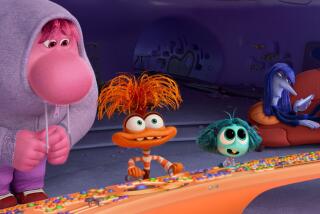American Television: Closing the Window on an Alien World
- Share via
By 1988, the average television viewer in America had the set on for six hours and 59 minutes each day.
That’s quite a lot considering we use part of each day for non-essential things like eating and sleeping and brushing our teeth.
In a single week, the average viewer sees about 1,000 TV commercials. And this, I always figured, is how television sells us things.
But I was only partially correct. As I learned from listening recently to George Gerbner, dean of the Annenberg School of Communications at the University of Pennsylvania, television sells us things much more profound than products and in a much more powerful and subtle way than through commercials.
Television sells us a picture of ourselves and the world we live in. Television sells us a culture and a society and our place in that culture and society.
And both the means and results are not always pleasant.
Gerbner, one of America’s leading communications theorists and researchers, has spent more than 20 years studying what television does and how it affects us.
And if you think that’s not important to the future of our country--far more important even than who we elect as President--consider this:
“Three out of four American kids grow up today in a home without a full-time parent,” Gerbner says, “but with the television on an average of seven hours a day.
“Most of the stories about life and values are told not by parents, grandparents, teachers, clergy or others with their own stories to tell, but by a handful of distant conglomerates with something to sell.”
And the average 10-year-old, Gerbner points out, “can name more brands of beer than Presidents.”
But what does TV really sell? Not just beer or soft drinks. It sells a view of life. Consider this from Gerbner’s research:
* On television, men outnumber women 3-1. On news shows, this climbs to 6-1. And on children’s programming it is 8-1.
* More than half of all the people we see on TV are white males in the prime of life.
* Most stories on TV are stories about power, threats, dangers and the avoidance of threats.
* The “lesson” of TV programming is that for white males all things in life are possible (except having children, which, Gerbner points out, isn’t presented as that much of a plus, anyway.)
* For 27 years, Gerbner says, the number of acts of violence on TV has remained stable: About six to eight per hour. Except, that is, on children’s programming where the number climbs to 20-35 per hour. (“Cartoons,” Gerbner says, “are a humorous way of sugar-coating violence.”)
* “Crime (on television) is at least 10 times as rampant as in real life,” Gerbner says. “Those who protect us from it and other risks of life--law enforcers, attorneys, judges, doctors and other health professionals, are vastly overrepresented, and, I might add, over-idealized.”
* As the social status of the character on TV goes down, his chances of being a victim goes up.
* Heavy television viewers project a much more dangerous universe, one in which risk is exaggerated. Heavy television viewers buy more locks, dogs, and guns to protect themselves and their homes than do light television viewers.
“If you are a heavy TV viewer,” Gerbner says, “you will think of the world as a mean and dangerous place.”
So what? It’s just TV, you say. Wrong. What we see on TV affects how we feel about real life.
Gerbner has found, for instance, that opposition to “homosexuality, abortion, legalizing marijuana, and to allowing ‘leftists’ and ‘rightists’ to speak freely is greater among heavy viewers than among comparable groups of light viewers.
“The mean and dangerous world of television also cultivates hard-line postures,” he says. “More viewing goes with (favoring) more money for defense and for fighting crime and drug abuse.”
Remember how I said that what appears on TV day in and day out is even more important than who we elect as President? I believe that. And Presidents believe it, too. That is why presidential campaigns so closely monitor the desires of the TV generation.
So what do heavy viewers of TV want? This, according to Gerbner:
“They want lower taxes but better education, cheaper medical care, solid Social Security and roads without potholes. They distrust big government, but want it to fix the economy, make the streets safe for their daughters and the world safe for what is defined for them as democracy. They scorn “The Establishment,” but dote on the rich and famous. They praise freedom, but fear anyone who uses it. Feeling threatened in the violent world they see on television, they condone and even welcome repression if it tends to enhance their sense of security and morality.”
Gerbner likes to tell a little story about the pervasive power of television and its ability to shape thought and outlook.
In his story, the teacher asks her grade-school class: “Who can tell me what the 20th Century owes Thomas Edison?”
“Without Thomas Edison,” one child replies, “we would be watching television by candlelight.”
More to Read
The complete guide to home viewing
Get Screen Gab for everything about the TV shows and streaming movies everyone’s talking about.
You may occasionally receive promotional content from the Los Angeles Times.






